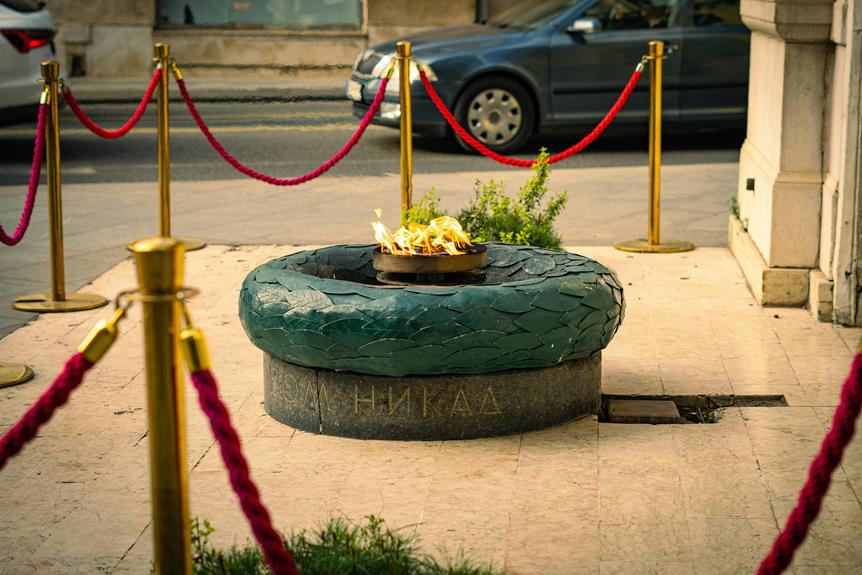The Nanjing Massacre Memorial Hall in China stands as an enduring monument to the harrowing events of the past, a somber reminder of the atrocities that once unfolded within its walls. Stepping into this memorial hall is akin to entering a portal to history, where the weight of remembrance hangs heavy in the air. Each corner holds stories untold, voices silenced, and memories etched in time. As visitors traverse through its halls, they are confronted with the stark realities of war and humanity's capacity for both cruelty and resilience. Yet, beyond the shadows of the past lies a beacon of hope, urging us to reflect, learn, and never forget.
Key Takeaways
- Architectural homage with clean lines and grey stone exterior.
- Diverse exhibits include survivor testimonies and forensic evidence.
- Provides a place for remembrance, healing, and emotional connection.
- Offers educational programs and community outreach initiatives.
- Hosts various memorial events, including an annual commemoration ceremony on December 13th.
History of the Nanjing Massacre
The history of the Nanjing Massacre is a tragic and well-documented event that took place during the Second Sino-Japanese War, specifically from December 1937 to January 1938. Also known as the Rape of Nanjing, this period was marked by the mass killing and atrocities committed by the Japanese Imperial Army against Chinese soldiers and civilians in the city of Nanjing, then the capital of the Republic of China.
The legacy of the Nanjing Massacre is one of immense suffering and loss, with estimates of the death toll ranging from 200,000 to 300,000 people. The event left deep scars on the collective memory of the Chinese people and continues to be a point of contention in Sino-Japanese relations. The historical significance of the Nanjing Massacre lies in its portrayal of the brutalities of war and the importance of remembering past atrocities to prevent their recurrence in the future. It serves as a stark reminder of the horrors that can result from unchecked aggression and the dehumanization of others.
The Nanjing Massacre Memorial Hall in China stands as a solemn tribute to the victims of this dark chapter in history, serving as a place of remembrance and education for visitors from around the world. It plays an essential role in preserving the memory of the massacre and honoring those who lost their lives during that tragic period.
Architecture and Design
In the context of the Nanjing Massacre Memorial Hall in China, the architecture and design of the memorial site reflect a somber and respectful homage to the victims of the tragic events that transpired during the Nanjing Massacre. The architectural features of the memorial hall are characterized by a solemn and austere aesthetic. The building is designed with clean lines and simple forms, evoking a sense of dignity and reverence. The exterior of the memorial hall is made of grey stone, symbolizing strength and resilience in the face of adversity.
Inside, the design elements further enhance the atmosphere of remembrance and reflection. The spacious halls and high ceilings create a sense of openness, allowing visitors to contemplate the magnitude of the tragedy that took place in Nanjing. The use of natural light streaming in through large windows adds a peaceful ambiance to the interior spaces, encouraging quiet contemplation and introspection.
Furthermore, the arrangement of exhibits and artifacts within the memorial hall is carefully curated to guide visitors through a chronological journey of the events of the Nanjing Massacre. The design makes certain that visitors are able to pay their respects to the victims while also learning about the historical significance of the tragedy. Overall, the architecture and design of the Nanjing Massacre Memorial Hall provide a poignant and dignified setting for honoring the memory of those who lost their lives during one of the darkest periods of Chinese history.
Exhibits and Artifacts
Within the Nanjing Massacre Memorial Hall, visitors encounter a diverse collection of exhibits and artifacts that vividly depict the historical events surrounding the tragic Nanjing Massacre. These exhibits serve as powerful affirmations to the atrocities committed during the massacre. Survivor testimonies play an important role in the exhibits, providing firsthand accounts of the horrors experienced by the victims. These testimonies humanize the tragedy, giving visitors a personal connection to the events that unfolded.
In addition to survivor testimonies, the Memorial Hall also showcases forensic evidence that validates the brutality of the massacre. Artifacts such as clothing riddled with bullet holes, blood-stained weapons, and skeletal remains unearthed from mass graves serve as tangible reminders of the violence inflicted upon the innocent victims. Through these artifacts, visitors can gain a deeper understanding of the scale and intensity of the atrocities that occurred.
The exhibits and artifacts within the Nanjing Massacre Memorial Hall aim to educate visitors about this dark chapter in history while honoring the memory of the victims. By presenting a detailed portrayal of the events through survivor testimonies and forensic evidence, the Memorial Hall ensures that the legacy of the Nanjing Massacre is not forgotten.
Commemorating the Victims
Through solemn ceremonies and thoughtful memorials, the victims of the Nanjing Massacre are commemorated with dignity and respect. The Nanjing Massacre Memorial Hall serves as a place for remembrance and healing, offering visitors a space to honor the memory of the victims and reflect on the atrocities committed during this dark period in history.
One of the ways in which the victims are commemorated is through art. Art installations within the memorial hall serve as powerful reminders of the suffering endured by the victims. These artistic representations not only pay tribute to those who lost their lives but also help in the healing process for survivors, families, and the broader community affected by the massacre. The creative expression found in these artworks allows for a deeper emotional connection and a more profound understanding of the events that transpired.
Moreover, the act of remembrance through art provides a platform for individuals to express their grief, anger, and hope for a better future. It serves as a medium through which the stories of the victims can be preserved and shared with future generations, ensuring that the memory of the Nanjing Massacre lives on. Overall, the commemoration of the victims through art plays an important role in acknowledging the past, fostering healing, and promoting a collective commitment to never forget the horrors of war.
Visitor Experience and Impact
Improving the overall visitor experience at the Nanjing Massacre Memorial Hall entails a thorough evaluation of the site's historical significance and the emotional impact it has on those who visit. The memorial importance of the site lies in its role as a confirmation to the atrocities committed during the Nanjing Massacre of 1937. Visitors are confronted with historical artifacts, photographs, and personal accounts that vividly depict the horrors endured by the victims, evoking a strong emotional response.
The impact on visitors is profound, often stirring feelings of sorrow, empathy, and reflection. Many experience a deep sense of mourning for the lives lost and a renewed commitment to peace and reconciliation. The emotional weight of the memorial serves as a poignant reminder of the consequences of war and the importance of preserving historical memory.
The layout and design of the memorial hall play a significant role in shaping the visitor experience. The somber atmosphere, respectful displays, and informative exhibits create a space for contemplation and remembrance. Additionally, interactive elements such as documentary screenings and educational materials enhance understanding and engagement with the historical narrative.
Educational Programs Offered
The Nanjing Massacre Memorial Hall provides a range of educational programs aimed at deepening visitors' understanding of the historical context surrounding the tragic events of the Nanjing Massacre. One of the key educational offerings at the Memorial Hall is educational workshops. These workshops are designed to engage visitors in interactive learning experiences, allowing them to explore further into the historical significance of the Nanjing Massacre. Through multimedia presentations, guided discussions, and hands-on activities, participants are able to gain a thorough understanding of the events that transpired during this dark period of history.
In addition to educational workshops, the Memorial Hall is actively involved in community outreach. By collaborating with schools, universities, and local organizations, the Memorial Hall extends its educational programs to a wider audience. Community outreach initiatives include organizing educational seminars, hosting outreach events, and providing resources for educators to incorporate the history of the Nanjing Massacre into their curriculum. These efforts aim to make sure that the memory of the Nanjing Massacre is preserved and passed down to future generations, fostering a greater awareness and understanding of this tragic chapter in history.
Memorial Hall Events
What events are hosted at the Nanjing Massacre Memorial Hall to commemorate the historical significance of the Nanjing Massacre?
The Memorial Hall organizes a variety of memorial events throughout the year to honor the victims and survivors of the tragic event. These events serve as a way to preserve the memory of the atrocities committed during the Nanjing Massacre and to educate visitors about this dark period in history.
One of the most poignant events held at the Memorial Hall is the annual commemoration ceremony on December 13th, the anniversary of the Nanjing Massacre. During this ceremony, dignitaries, survivors, descendants, and members of the public gather to pay their respects to the victims and reflect on the impact of the massacre. Survivor stories are often shared during this event, providing a firsthand account of the horrors endured by the people of Nanjing.
In addition to the annual commemoration ceremony, the Memorial Hall also hosts special exhibitions, lectures, and cultural performances throughout the year. These events aim to deepen visitors' understanding of the Nanjing Massacre and its lasting effects on individuals and society as a whole. By engaging with survivor stories and participating in memorial events, visitors can uphold the memory of the Nanjing Massacre lives on and that the victims are never forgotten.
Importance of Remembering
Reflecting on the events hosted at the Nanjing Massacre Memorial Hall to commemorate the historical significance of the Nanjing Massacre underscores the profound importance of remembering the atrocities of the past. The impact of remembering such tragic events serves as an essential reminder of the consequences of war and the importance of upholding human rights and dignity. By acknowledging and honoring the victims of the Nanjing Massacre, society can learn from the past to prevent similar atrocities from occurring in the future.
Remembrance plays a significant role in shaping collective memory and fostering empathy and understanding among individuals. It helps preserve the stories of those who suffered and perished during the Nanjing Massacre, ensuring that their experiences are not forgotten or overlooked. Through remembrance, we honor the resilience and courage of the survivors, paying tribute to their strength in the face of unimaginable adversity.
Furthermore, the act of remembering promotes healing and reconciliation, both on a personal and societal level. It allows for reflection on the darker chapters of history and encourages dialogue to promote peace, forgiveness, and mutual understanding. By confronting the painful truths of the past, we pave the way for a more compassionate and tolerant future, where respect for human life and dignity prevails. Essentially, the importance of remembering the Nanjing Massacre lies in its ability to educate, inspire, and unite individuals in the pursuit of a more just and peaceful world.
Frequently Asked Questions
What Is the Significance of the Color Scheme Used in the Memorial Hall?
The color scheme in a memorial hall holds symbolic significance, serving as a visual representation of the theme and purpose of the space.
Colors are carefully chosen to evoke emotional responses from visitors, aiming to create an atmosphere of reverence, remembrance, and contemplation.
Are There Any Interactive Exhibits for Visitors to Engage With?
Visitors to the memorial hall have access to a range of interactive activities that enhance engagement and encourage visitor participation. These interactive exhibits provide unique learning opportunities for visitors to explore further into the historical significance of the events commemorated.
Through interactive displays, visitors can actively engage with the content presented, fostering a more immersive and educational experience within the memorial hall.
How Are the Victims' Stories Preserved and Shared Within the Memorial Hall?
Victims' narratives within memorial halls are preserved through various means, including written accounts, audiovisual recordings, and artifacts.
Educational programs play a vital role in sharing these stories with visitors, offering guided tours, workshops, and lectures that provide historical context and personal accounts.
What Measures Are Taken to Ensure the Accuracy of Historical Information?
Ensuring historical accuracy involves employing rigorous research methods such as:
- Cross-referencing multiple sources
- Analyzing primary documents
- Consulting experts in the field
Are There Any Virtual Tours or Online Resources Available for Remote Visitors?
In response to the current question regarding virtual tours and online resources, many historical sites have adapted to offer remote visitors immersive experiences through virtual tours and a wealth of online resources.
These digital platforms provide an opportunity for individuals worldwide to explore the historical significance of various sites from the comfort of their homes, offering a valuable resource for those seeking to engage with history in a dynamic and interactive manner.
Conclusion
To sum up, the Nanjing Massacre Memorial Hall stands as a beacon of remembrance, honoring the victims of one of the darkest chapters in history.
Like a somber melody that echoes through time, the memorial hall serves as a poignant reminder of the atrocities committed during the Nanjing Massacre, ensuring that the memory of the victims will never be forgotten.


